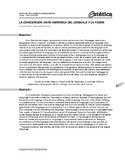La concepción onto-histórica del lenguaje y la poesía

Date
2009-07-21Auteur
Palabras Clave
Ereignis, Patencia del Ser, Lenguaje y su carácter histórico, Peligrosidad del lenguaje, Silencio, Diálogo, Campanilleo de la calmaMetadatos
Afficher la notice complèteRésumé
En su filosofía del Ereignis (apropiación mutua de hombre y Ser), Heidegger piensa Ser y lenguaje en íntima conexión. La patencia del Ser acontece ineludiblemente en el lenguaje; pero también, la esencia del lenguaje en la esencia del Ser. En virtud del lenguaje, el hombre es el testigo del Ser. En la comprensión de esto, es decisivo tener presente que la esencia del lenguaje no es una posesión del hombre, sino más bien lo es éste de aquella. El hombre es arrobado por el Ser que acontece (geschieht) en el lenguaje y es así sostenido por él en su carácter histórico (geshichtlich). No sólo el hombre
posee este carácter, sino también el Ser y el lenguaje mismos. El lenguaje en su carácter histórico fundamental ha de ser determinado a partir de la poesía, toda vez que ella constituye el acontecimiento extraordinario del lenguaje. A partir de la poesía de Hölderlin es visible la doble peligrosidad del lenguaje, como su determinación esencial más alta: I) El peligro de la cercanía más alta de los dioses y, con ello, la aniquilación excesiva por ellos. II) El peligro de alejarse hacia la habladuría desgastada y su apariencia. El lenguaje es determinado más precisamente aún como diálogo; en conexión con el diálogo se encuentra el fenómeno del silencio, que pertenece al fenómeno no-humano de la gran calma (die grosse Stille), llamada también por Heidegger en su obra tardía el campanilleo de la calma (das Ge-läut der Stille). Con esta expresión designa la esencia originaria del lenguaje.
Colecciones
Información Adicional
| Correo Electrónico | caracatoa@hotmail.com |
| ISSN | Revs-0002 |
| Resumen en otro Idioma | In his philosophy of Ereignis (appropriation of men and Being), Heidegger thinks Being and language in intimate connection. The patency of Being inevitably happens in the language, but also the essence of language in the essence of Being. Under language, the man is the witness of Being. To understand this, it is critical to bear in mind that the essence of language is not a possession of the man, but rather what is the man of language. The man was ecstatic by the Ser, which unfolded (geschieht) in the language and is sustained by it as a historic (geshichtlich). Not only the man has that character, but also the Being and language. The language in its historical key is to be determined from poetry, whenever it is the extraordinary event of language. Based on the poetry of Hölderlin is visible double danger of language, as its highest essential determination: I) The danger of the highest proximity of the gods and thus excessive annihilation for them. II) The danger of exiting towards the worn chatter and appearance. Language is more precisely determined even as dialogue. In connection with the dialogue is the phenomenon of silence, which belongs to the non-human phenomenon of the great calm (die grosse Stille), this is also called by Heidegger in his late work "the peal of silence" (das Ge-läut der Stille). |
| Colación | 31-40 |
| Periodicidad | semestral |
| Publicación Electrónica | Revista Estética |





